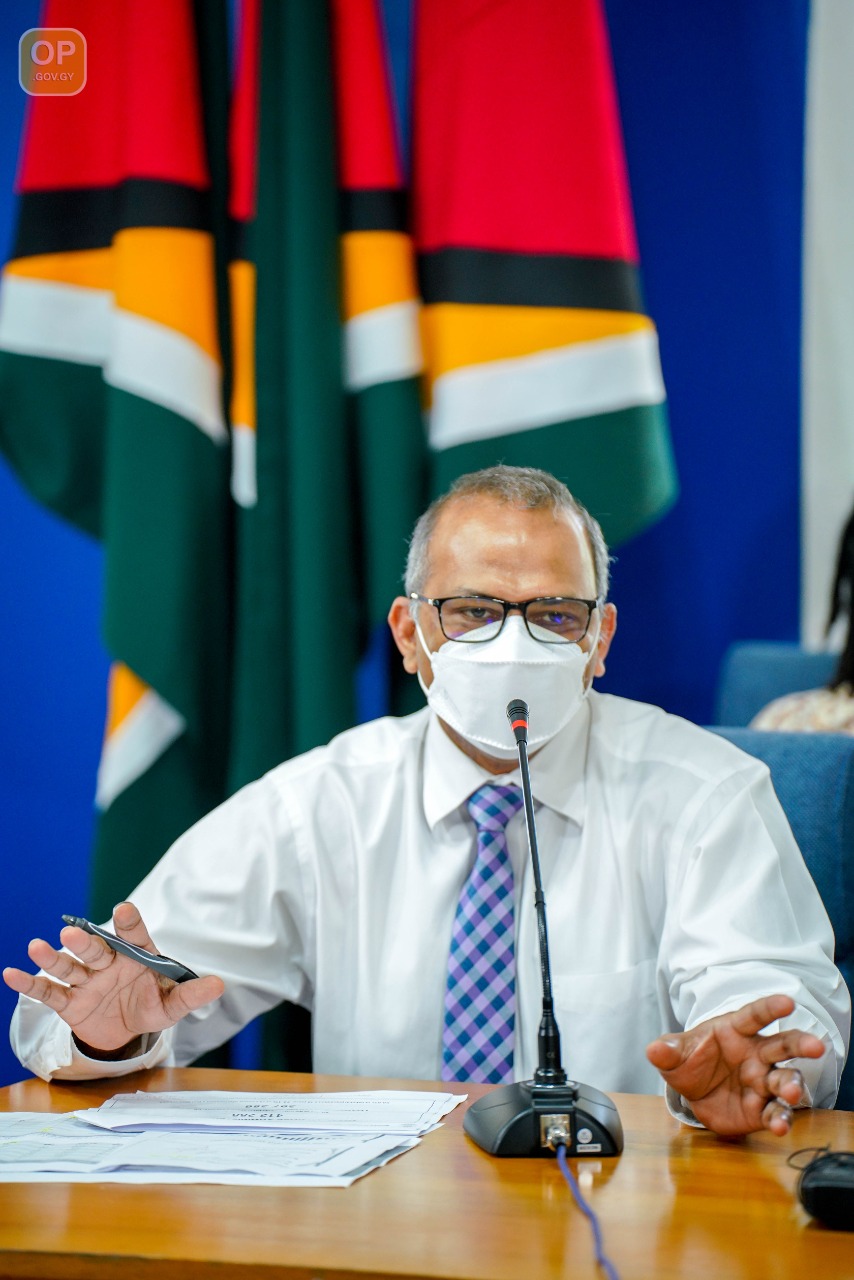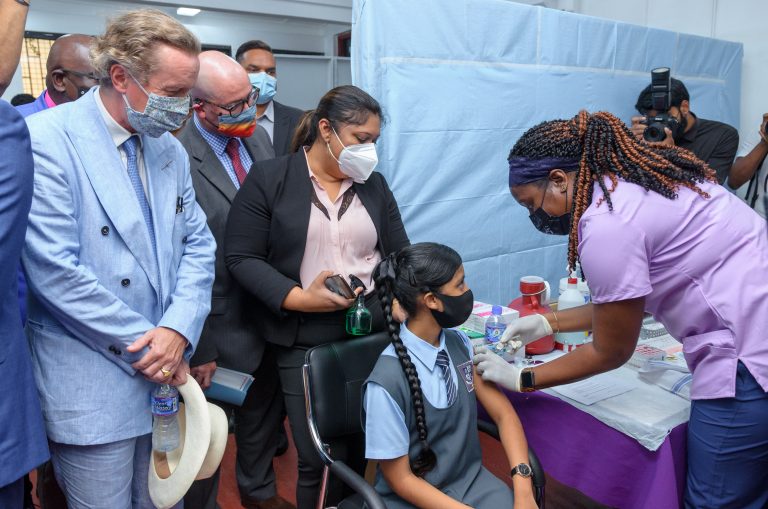Two years on: Has COVID become a ‘balancing act’?
By Vishani Ragobeer
Guyana recorded its first COVID-19 case and death on March 11, 2020. Now, two years later, restrictions are being lifted and there is a gradual return to life before the pandemic- though, perhaps, with some changes.
“The world is now in its [second] year of the pandemic and people really want some more of their freedoms.
“It’s always a challenge of how you make this balance- not only [with] strict public health measures, but with the economic viability of the country,” Guyana’s Minister of Health Dr. Frank Anthony told the News Room during an interview on Thursday.

March 11, 2020, was also the day that the World Health Organization (WHO) declared the spread of the novel coronavirus a pandemic. Since then, countries have grappled with varying restrictions on gatherings and upped health guidelines to protect populations.
Guyana has been no different.
Each month, routinely, the country would institute or extend its COVID-19 measures that detailed the restrictions on social gatherings and travel, for example. A national curfew, which varied overtime, was only lifted last month.
Still, the health threat has not been eliminated. Guyana has recorded a total of 63,107 COVID-19 infections over the two-year period; 1,224 people have died.
Behind these figures, there are real people, each affected in their own way.
Take News Room Journalist Isanella Patoir, for example. During the first year of the pandemic, she was pregnant; she gave birth to her baby boy in April 2021.
PREGNANCY AND COVID
Based on information from the United States (US) Centers for Disease Control and Prevention (CDC), pregnant women and new mothers are more likely to experience the more severe symptoms of COVID-19.
Pregnancy, the CDC said, causes changes in the body that could make it easier to get very sick from respiratory viruses like the one that causes COVID-19.
“I was very worried because at the time, there were many concerns about pregnancy and COVID-19 but most of all I was afraid I would be the only person in the delivery room and I didn’t want that,” Patoir said.
She indeed was alone in the delivery room, well, except for the medical team delivering her baby. And this sort of isolation was part of the COVID-19 guidelines instituted to help control the spread of the virus.

There were also health concerns about pregnant women receiving the life-saving COVID-19 vaccines. Studies were first needed to ascertain that those vaccines would not result in any adverse reactions for pregnant women or new mothers.
Eventually, Guyana’s vaccination campaign was extended to pregnant women after international studies confirmed the safety of the vaccines. And Patoir got vaccinated in July 2021.
By November that year, however, she was infected with the dreaded virus.
“I did test positive for COVID-19 a few months after I delivered [my baby] but it wasn’t as terrifying because I think I knew that I had COVID-19,” Patoir said, explaining that she realised she lost her taste and smell a few days before.
Because she was aware that these are signs of COVID-19, she isolated from her baby boy – a move that was wise since a polymerase chain reaction (PCR) test confirmed that she was positive days after.
At that time, Guyana appeared to be exiting the wave of COVID-19 infections caused by the deadly Delta variant. The new mother was not terrified though.
“I wasn’t in the hospital and I was fully vaccinated so I felt safe knowing that I would’ve recovered in a short space of time.
“I really think that being vaccinated helped me to rebound faster from COVID than I would have if I wasn’t vaccinated,” she said.
Vaccination has been touted as the one of the available medical tools to help protect people from experiencing the more severe or life-threatening symptoms of COVID-19. And even now, Dr. Anthony emphasised that a better understanding of COVID-19 coupled with widespread vaccination and better-equipped medical facilities have been helping the local authorities to fight the scourge.
He also believes that the virus and disease themselves have been evolving, forced to grapple with an increasingly immunised population.
The Health Minister explained that the newest variant of concern – Omicron – did cause many more people to become infected but it was not as deadly as the Delta variant.
“Because of this change, I think we are still seeing a much milder version of [COVID-19] but we still don’t know what might be the consequences of long COVID and that is why people should be guarded,” Dr. Anthony said.
He hastened to add, “I think that once we have reasonably high vaccination rates and with some of the public health measures in place like high vaccination and so forth, we can go back to some level of normalcy.”
THREAT REMAINS
Dr. Anthony’s optimism is not necessarily shared by other health experts – at least not yet.
At a weekly online briefing earlier this week, Pan American Health Organization (PAHO) Director Dr. Carissa Etienne emphasised that countries should be wary of prematurely lifting the COVID-19 restrictions.
“When places relax measures at the wrong moment, transmission spikes dangerously and we lose more lives.
“… COVID-19 is likely to be here to stay. We must learn to live with this virus, and quickly adapt to new changes,” Dr. Etienne emphasised.

Like Dr. Anthony, she believes that vaccines are one of the best available tools to combat the continued spread of the novel coronavirus. And so she called for many more people, particularly those still unvaccinated to get the jab.
Dr. Anthony also touted the use of COVID-19 treatment drugs – Remdesivir, Barcitonid, Paxlovid and Molnupiravir. These are all drugs that help to treat COVID-19, particularly for those patients hospitalised with the more severe and life-threatening symptoms of COVID-19.
CHILDREN AND COVID
With all of the medical weapons to fight COVID-19, Guyana’s Health Minister appears confident that the disease can be better managed – so much so that he supports the full return to classrooms in a matter of weeks.
Since the start of the pandemic, more than 7,800 children have been infected and at least 17 have died. Even so, Dr. Anthony said that the data shows that children are more likely to experience the mild symptoms of COVID-19, if they experience any symptoms at all.
The danger with allowing children to return to schools, however, is that the children may contract the infections in school and spread the infection to older, more at-risk individuals in their household.
“We’ll obviously continue to monitor,” Dr. Anthony said.

He also related that the Ministries of Health and Education, alongside parents and teachers, have to commit to maintaining the COVID-19 guidelines in schools.
Additionally, the Health Minister reminded Guyanese that there is an abundance of Pfizer vaccines for children aged 12 to 17 years old. The government, he said, is also still seeking the special Pfizer vaccines for children aged five to 11 years old.
For children and adults, Dr. Anthony continued to emphasise that vaccination is crucial.
“We still have pockets of people who are hesitant and we continue to work with them to make sure they understand the need to get vaccinated,” he said.
As more restrictions are lifted locally, Dr. Anthony is hoping that many more people can get vaccinated and he has tapped his healthcare workers across the country to help eliminate the hesitancy and drive up vaccination numbers.







